The Indian middle order — A tale of changing relationships
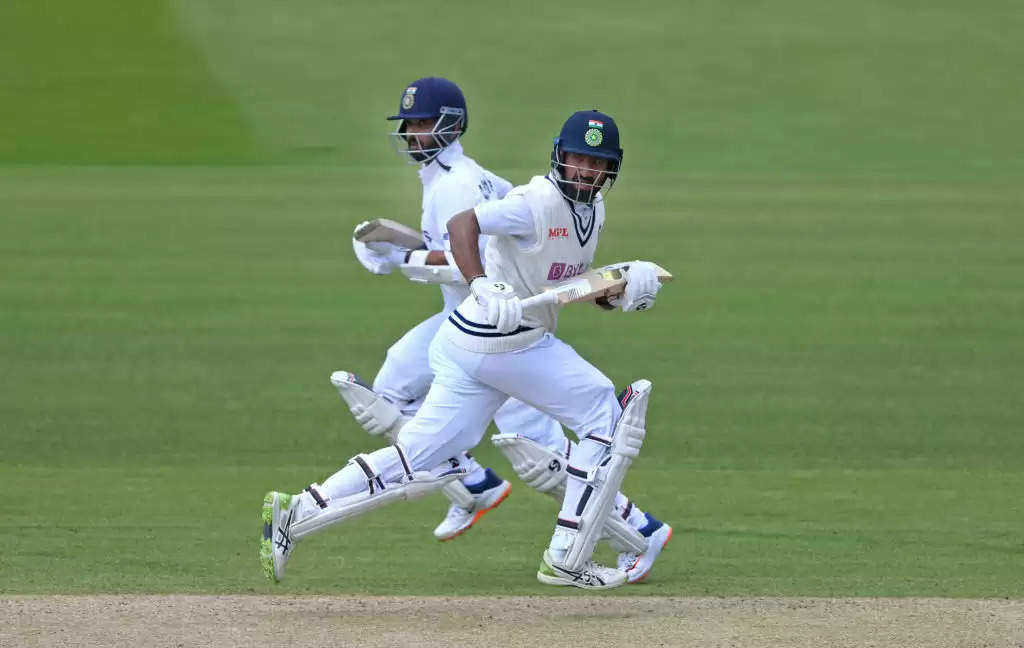
There’s this relationship you’re in. It’s been more than eight years. You’ve had some amazing moments which you’ll cherish for a lifetime. But (there’s always a but), it has started to sour. You don’t know if you should keep giving it more chances because of what it has given you in the past, or if you should break up and move on. This is where the Indian Test team’s relationships with Cheteshwar Pujara and Ajinkya Rahane stand at the moment. At least, that is what it seems like from the outside.
There’s another relationship, this time between the father figure of a family, and the family. He used to provide for them and often carry them single handedly during tough times. He needs help now.
Thankfully, under his guidance, the family has become self-sufficient and despite him not being able to contribute like he used to before, they are doing pretty well. The family, as you might have guessed, is the Indian Test team, and the father figure, Virat Kohli.

A lot has been said and written about Pujara, Kohli, and Rahane, India’s 3, 4, and 5, in recent times. This article will add another drop to that ocean, albeit a very statistical one. To begin with, let’s establish exactly how good the good times were in the Indian team’s relationships with Pujara and Rahane, and exactly how much Kohli used to provide for them.
The slide in the trio’s returns started since the New Zealand tour in 2020. Before that, for the last 4–5 years, they were collectively plundering runs for fun. Hence, as a benchmark, we’ll be comparing their numbers from 2016–2019 and from 2020 to the present day.
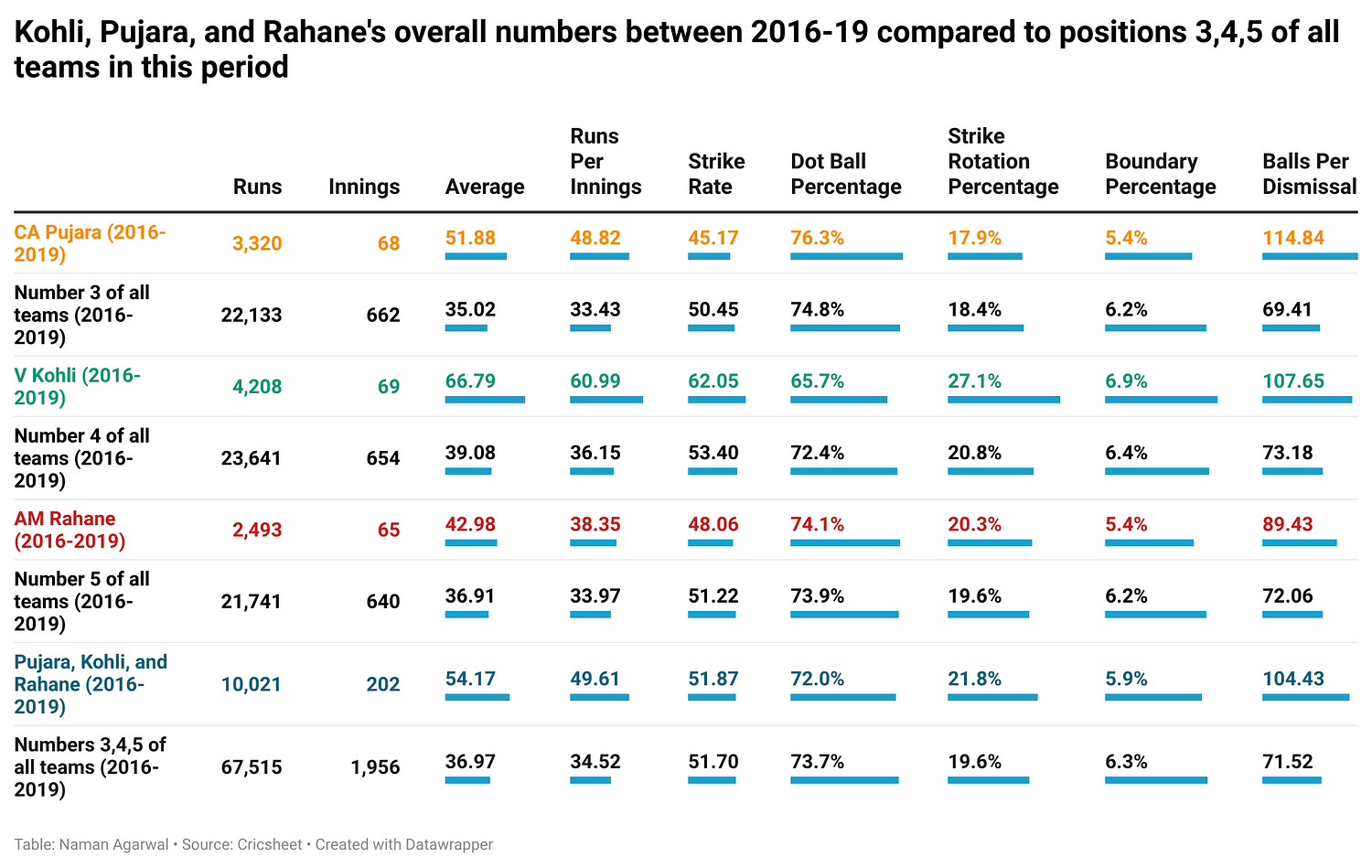
Pujara averaged almost 17 runs more than the average number 3 in Test cricket between 2016–19. Virat averaged almost 25 runs more, and Rahane averaged about 6 runs more than the average numbers 4 and 5 during that period. Collectively, these three averaged almost 18 runs more than the average 3,4,5. This is exactly why it is so difficult to let go of the Pujara and Rahane relationships. And this is exactly why the family doesn’t mind its father figure not contributing as much as he used to. When they’ve been good, they’ve been unmatchable.
Also Read: Virat Kohli’s template – perennially riddled with twists and turns
So, what has changed? Or rather, how much has changed? Since 2020, all three average less than the averages of their corresponding positions in Test cricket. Pujara averages almost 11 runs less than the average number 3, Kohli averages almost 17 runs less than the average number 4 and Rahane averages 5 runs less than the average number 5.

Players are expected to go through phases where their numbers don’t add up, and if they have quality and have previously proven themselves, teams can and should stick with them. But what’s hurting India, is the fact that the slump in the form of Pujara, Kohli, and Rahane has coincided, and the slump has been so steep, that from averaging much higher than the average of their respective positions in Test cricket, they have not only dropped close to the average numbers, but significantly below them.
Pujara’s methods are well known. Even when he was scoring big runs (2016–19), he was facing a much higher percentage of dot balls (76.3%) than the average number 3 batter (74.8%). Since 2020 though, he has taken his methods to their absolute extreme.
85.4% of the balls he has faced have been dots. Among batters who have scored more than 100 runs since 2020, only Hanuma Vihari has faced a higher percentage of dot balls (86.7%), and if you remove his hamstrung blockathon at Sydney, Pujara leapfrogs him to the top of that list.
Kohli’s strike-rate has dived from 62.05 between 2016–19 to 42.93 since 2020. He is facing more dot balls and rotating strike lesser. Same for Rahane, whose strike rate, dot-ball percentage, and strike rotation percentage used to hover around the average values of those metrics for all number 5 batters between 2016–2019. They no longer do and have dropped significantly below the average (strike rate down by 7 runs, dot ball percentage up by almost 3%, and strike rotation percentage down by 2.4% than the average number 5 since 2020).
Pujara has shut shop
Between 2016–2019, the only phase of his innings where Pujara faced more than 80% of dot balls, was his first 20 balls on the crease. After that, for every other phase of his innings, his dot ball percentage would fluctuate between 70% to 78.5%. Since 2020 though, his dot ball percentage has dropped below 80% only in the 200–250 and 250+ balls phase.
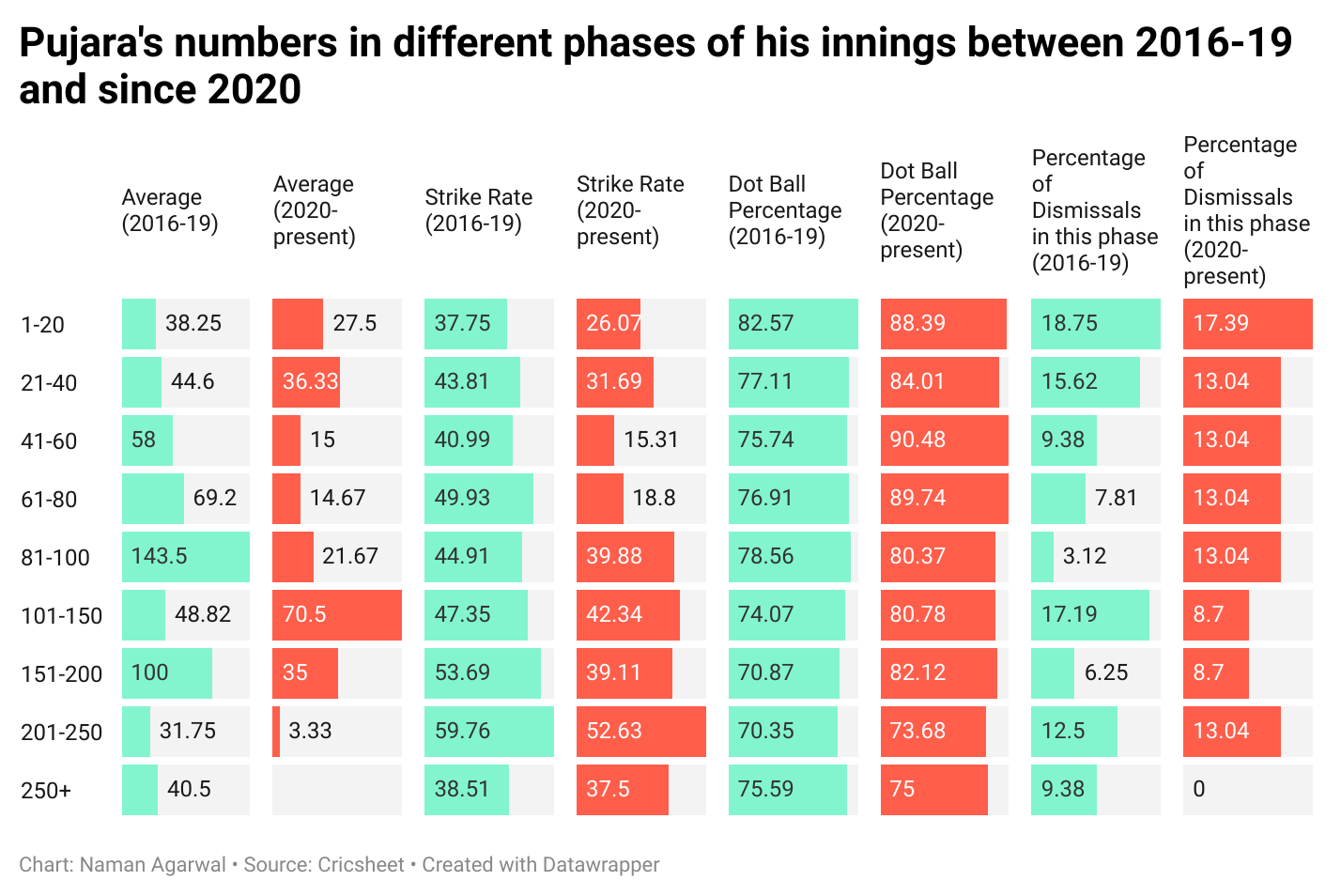
41–60 and 61–80 balls are the phases of your innings where you have got a fair idea of how the pitch and the ball are behaving and are relatively set on the crease. This is where you perhaps start finding the gaps and rotating the strike more. Pujara did the same, until 2020. Since then, his dot ball percentages in these two phases of his innings have surprisingly increased to a scarcely believable 90.48% and 89.74% respectively.
More than Pujara settling down after facing 40 balls, it feels as if the bowlers settle down more bowling to him. This change has occurred because he has put away some of his scoring options. He hardly drives on the off side to pacers, front foot or back, and almost never pulls nowadays. He doesn’t tap and run, or play the dab down to third man like many other all format batters do either.
Also Read: Does Cheteshwar Pujara need to alter his method for English conditions?
Lesser pressure applied on the bowler → greater accuracy and control for the bowler → more chances of getting a good ball with your name on it. And this reflects on his percentage of dismissals in the 41–60, 61–80, and 81–100 balls phases. 9.28%, 7.81%, and 3.12% of all his dismissals were in these three phases respectively between 2016–19. Those three numbers have increased to 13.04% for each phase since 2020. Pujara 2.0 has eliminated the concept of getting settled on the crease.
Kohli can’t find any rhythm
We know how Virat Kohli is one of the most busiest batters at the crease, be it T20s, ODIs, or Tests. His defensive pushes and leaves are filled with as much energy as a full blooded pull shot. Between 2016–2019, the dot ball percentage in his first 20 balls used to be 71.62%. Among top and middle order batters who scored more than 500 runs in their first 20 balls in that period, only David Warner had a lower dot ball percentage — 70.86%.
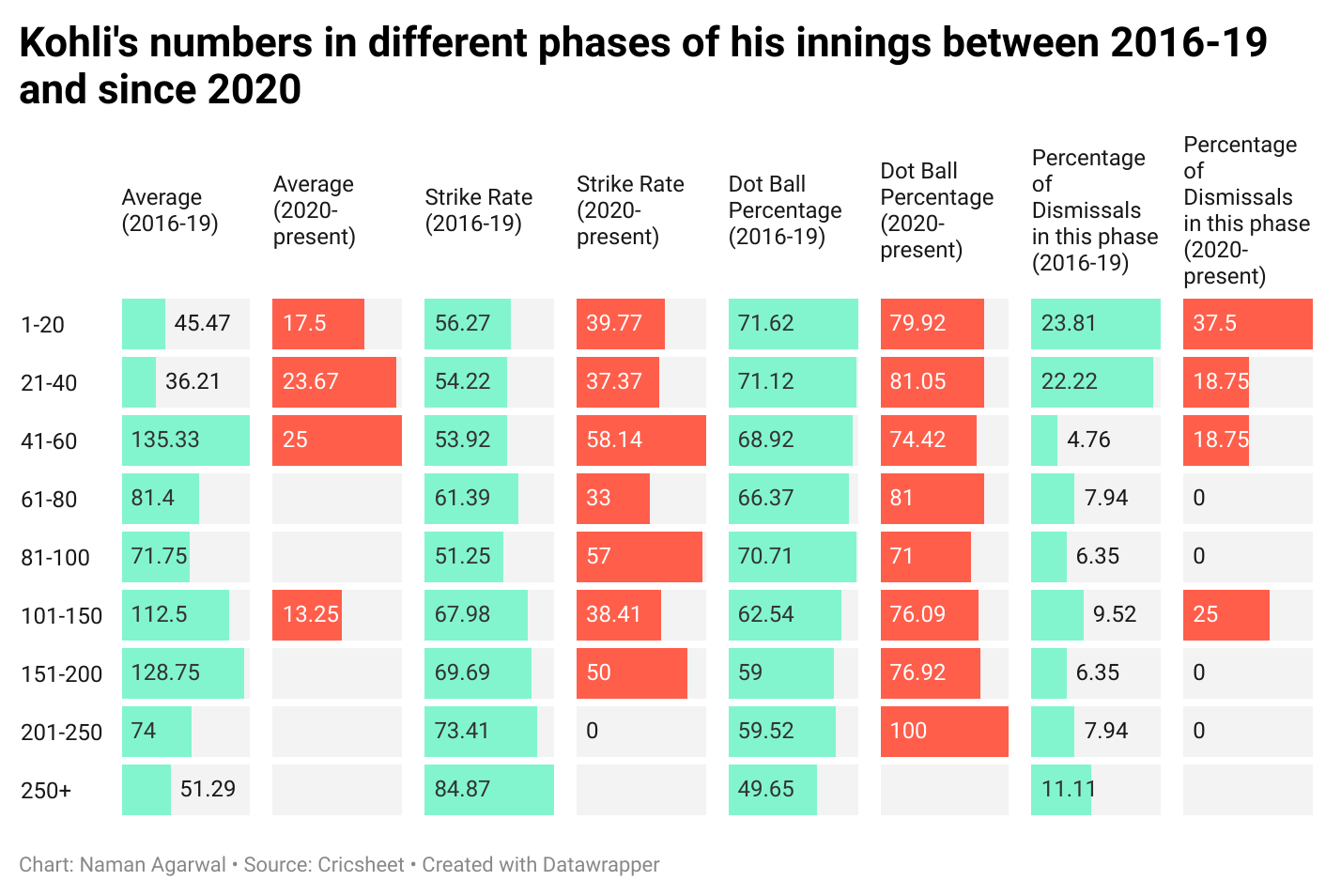
That has changed now. He is still as busy on the crease as before, but that is not converting into early runs. His dot ball percentage in his first 20 balls has moved up to almost 80%. He isn’t able to ‘get off the blocks’ as quickly as he used to. We’ve seen this with him in white ball cricket too, that if he doesn’t get going in his first 20–30 balls, it usually results in him getting out quicker. And that applies in Test cricket too. 23.81% of his dismissals used to be in the first 20 balls he faced between 2016–2019. Since 2020, that number has shot up to 37.5%.
That Kohli is not in great form can be best explained by his fluctuating strike rates in different phases of his innings since 2020. He is starting off much slower than he used to in his first 40 balls. Then he is picking up pace in the 41–60 ball phase to strike at almost 60. But he isn’t able to sustain that momentum, as his strike rate is falling back down to 33 in the 61–80 balls phase. His strike rate is alternatively increasing and decreasing for each phase after his first 20 balls. And pretty significantly so.
Rahane isn’t flamboyant anymore
Rahane used to be the kind of batter who liked to take one or two chances and get a boundary early on in his innings. And he was pretty successful at it, averaging 60 in his first 20 balls between 2016–2019. No other batter who scored more than 300 runs in their first 20 balls in that period, averaged anywhere close to that. Steve Smith came a distant second, averaging 51.45.
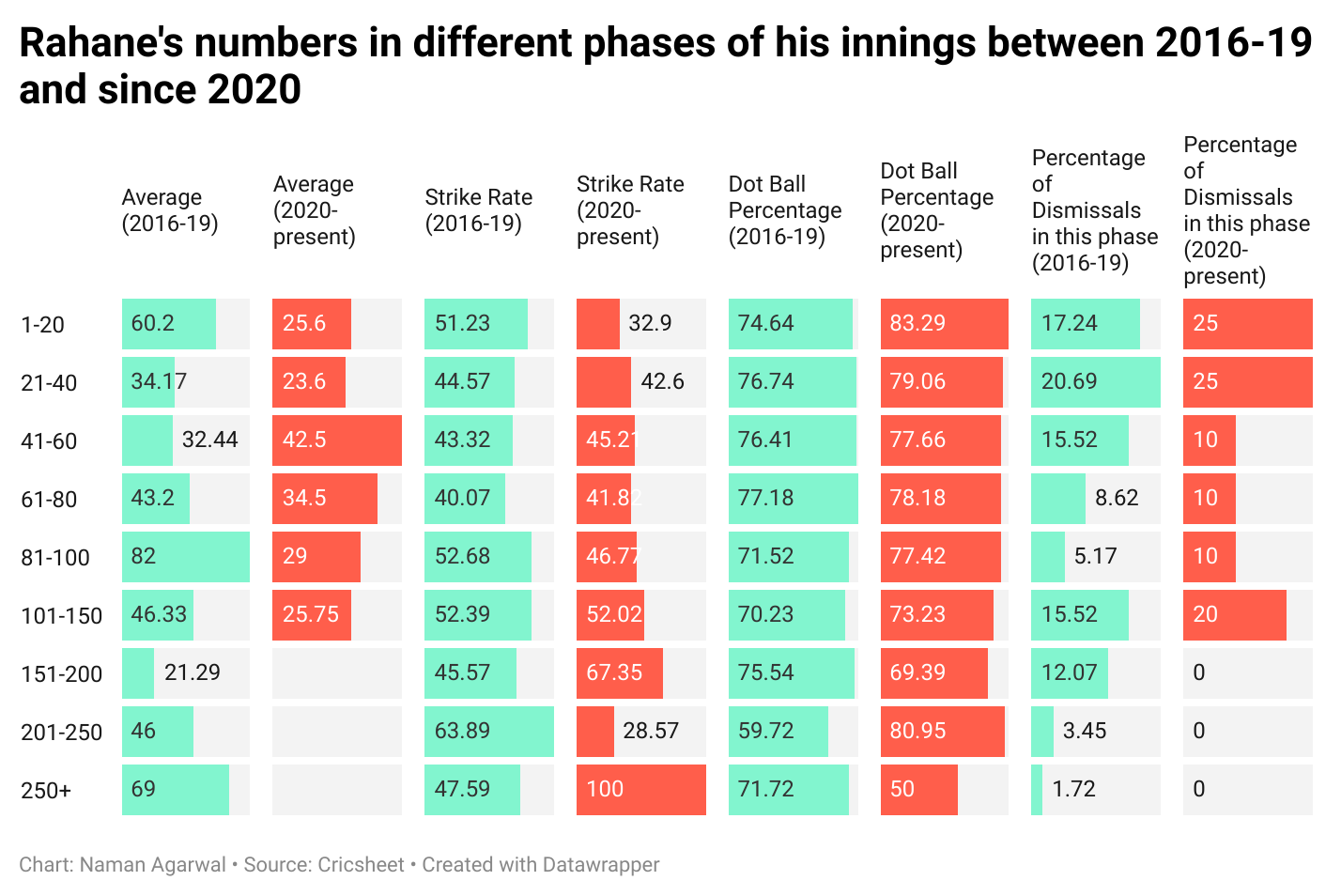
Since 2020, that average has fallen to 25.6. His dot ball percentage in his first 20 balls has increased by almost 9% too and his strike rate has dropped from 51.23 to 32.9. The Rahane of today doesn’t take any risk whatsoever early on in his innings. But that hasn’t helped him. He used to be a free flowing batter, but now his strike rate only crosses 50 in the 101–150 balls phase. And he rarely sticks around that long.
Also Read: Pujara and Rahane, two wounded fighters steer India to the path of glory
India are arguably the best test team in the world. That they are the best despite the crux of their middle order not performing anywhere near to potential, is a testament to how good they are. But the problem with this flaky middle order is that despite being the best team in terms of potential, they have had and will continue to have moments like 36 all out and 78 all out.
We’ve seen how good and how not-so-good the teams relationships with Pujara and Rahane have been. We’ve seen how tall Kohli has stood as the provider of this team, and how short he is on confidence and rhythm right now. The ongoing series has seen one fifty from all three of them and several failures. While there’s a sense of inevitability to Kohli’s eventual return to form, the same can’t be said for Pujara and Rahane. Yes, Pujara has had two good innings on the trot. But if him and Rahane don’t get any more substantial scores in this series, India might well be better off ending its relationships with at least one, if not both of them.

